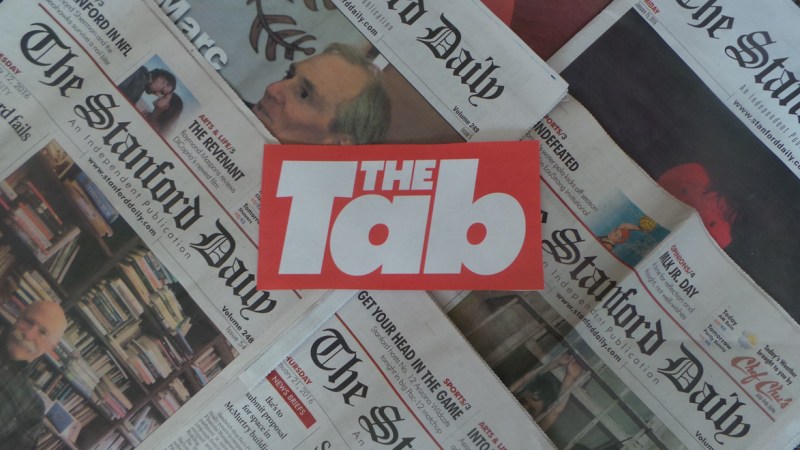Call it a British invasion: After launching web presences at colleges across the East Coast, The Tab — a U.K. based student news platform — has started publishing stories on their new “The Tab Stanford” section.
The Tab, which markets itself as a place for young people to write stories for other young people, joins sites such as The Odyssey Online and the food journalism website Spoon University to exemplify a broad trend: the rise of alternative collegiate publications that are owned and run primarily off-campus.
Founded at Cambridge University by three undergraduates in 2009, The Tab initially served as Cambridge’s first online-only paper. “Tab” is a pun on both “tabloid” and “Cantab,” a nickname for Cambridge students.
In 2012, the site expanded to 12 other British universities and evolved into a platform for students to publish stories relevant to life on their own campuses. The platform continued to spread to campuses around the U.K., and then, in July of last year — backed by $3 million in venture capital investments — The Tab opened its U.S. bureau in Brooklyn, New York and began an entry into the U.S. market. Throughout the fall of 2015, The Tab launched sites at 23 colleges across the East Coast, including all members of the Ivy League.
The Tab’s website advertises its “powerful, grassroots network of reporters”: the thousands of unpaid college students writing for the website. These collegiate writers work with a paid staff of around 60 people based in London and New York.
The Tab’s Stanford launch began on Dec. 1 last year, when Brad Vanstone, The Tab’s head of marketing, used an email listserv found online to send a recruitment email to Stanford undergraduates.
“Experience is not necessary,” Vanstone’s recruitment email read. “We are looking for intelligent people who want to cover original stories in a way which entertains and informs Stanford students.”
To sign up to write for The Tab, students simply answer a few short questions on a web form. There are no hiring interviews. New writers talk to editors in New York or London about their story ideas and can begin writing as soon as they please.
The Tab’s hiring process contrasts to that of other campus publications.
The Stanford Daily requires new reporters and writers to sign a code of conduct, study The Daily’s official ethical and stylistic expectations and attend multiple in-person training sessions; The Tab does not require writers to sign any expectations of conduct, and no training is required.
However, editors from The Tab make themselves available to writers throughout the drafting process, offering critiques of ideas and stylistic advice. Student writers primarily maintain contact with their editors online, through The Tab website chat features or Facebook messenger.
While The Tab’s publishing system is relatively relaxed — its recruitment emails promise to publish student stories the day they are sent in — Harry Shukman, one of The Tab’s news editors, stressed that The Tab takes its journalistic integrity very seriously.
“Lots of people are working constantly to make sure there are multiple pairs of eyes on every story, and to make sure nothing that goes out will be defamatory or slanderous,” Shukman said. “We’ll be with our writers every step of the way.”
Over email, Shukman explained that the fact-checking process for each Tab article involves a campus editor, a professional editor in New York and sometimes a senior editor “if the story is serious or warrants further attention.” A legal team also reviews articles deemed potentially “contentious.”
“I suspect our serious stories get more professional editing and fact-checking than any other piece of journalism written by a student,” Shukman said.
Jasmin Kamruddin ’18 signed up to write for The Tab after receiving Vanstone’s recruitment email. Kamruddin had never written for a newspaper before, but saw The Tab as an opportunity to write about her experience being black at Stanford — the subject of her first article, which was among the first batch published on The Tab’s Stanford section on Feb. 1.
“[The Tab’s editors] said that you could basically write about anything you want that’s happening around campus,” Kamruddin said. “They just want it to be relevant to Stanford.”
“It didn’t seem like too much of a commitment,” she added. “They don’t have deadlines or anything like that.”
Kamruddin and 25 other Stanford students met with editors from The Tab who flew out from New York to talk to potential writers for a day in late January.
Friend Chaikulngamdee ’16, who also writes for The Daily, was selected from a pool of 15 applicants to be The Tab’s campus editor at Stanford. A campus editor is an unpaid student and is the head of The Tab’s editorial team on a college’s campus.
Chaikulngamdee said she enjoyed working with The Tab’s editorial staff.
“The editors in New York are really down to earth,” she said. “They’re recent grads themselves; they understand college life.”
So far, The Tab Stanford has published a mix of news and opinion pieces, as well as personal pieces such as Kamruddin’s article on being black at Stanford, Astrid Casimire’s ’19 discussion of being an international student on campus and Niall Sohan’s ’19 short memoir of his time in the Singaporean army.
Many pieces have garnered hundreds — in some cases thousands — of pageviews: Sohan’s story, the most read on Stanford’s Tab, has over 10,000 views.
“The Tab is fundamentally a student platform for people to write about what interests them,” Chaikulngamdee said. “What’s exciting is that it’s not edited; it’s very real. You basically come up with whatever you want to write and you pitch it.”
Contact Jack Herrera at herreraj ‘at’ stanford.edu.
An earlier version of this article incorrectly stated that the Tab’s campus editors are the only members of the publication’s editorial team on their campuses. The Daily regrets this error.
